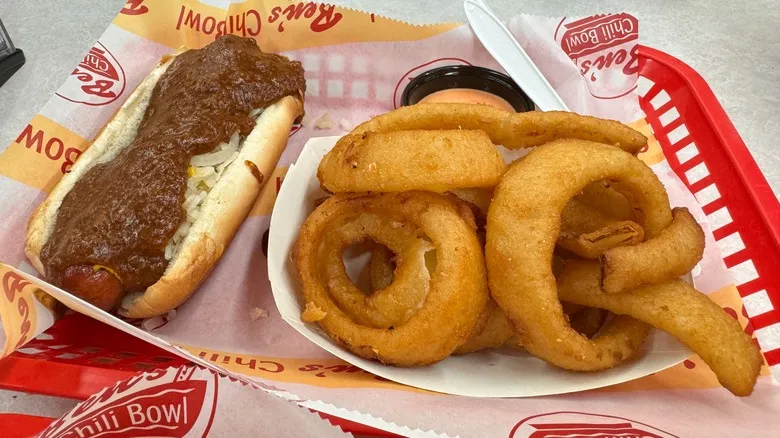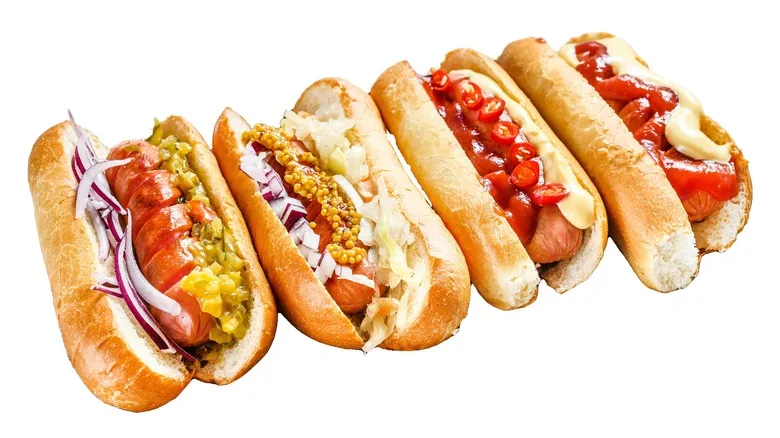All-beef/kosher/kosher-style/dirty water/New York

One of the most popular types of hot dogs that deviates from the traditional beef-pork blend is the all-beef hot dog. These can typically be found in the pre-packaged deli meat aisle of most U.S. supermarkets, thanks to the widespread availability of brands like Hebrew National and Nathan's Famous, making them quite accessible.
All-beef hot dogs can be categorized as kosher and kosher-style. The meat used in kosher hot dogs comes from animals that have been slaughtered in accordance with kosher laws, and they are produced in facilities that are certified kosher. Kosher hot dogs generally do not use natural casings; instead, they often feature collagen or kosher-certified vegetarian casings. On the other hand, "kosher-style" hot dogs are all-beef varieties that are seasoned similarly to kosher hot dogs but lack kosher certification. These typically have natural casings.
A notable regional variant of the all-beef hot dog is the dirty water dog. These are the hot dogs sold from the iconic street carts in New York City, often made with the kosher-style Sabrett brand, which uses natural casings. The term "dirty water dog" refers to the water in which they are boiled; while it may sound unappealing, the water is actually seasoned with spices and vinegar, imparting a unique flavor to the meat that pairs perfectly with classic toppings like mustard, sauerkraut, and onion sauce.
Sonoran

Venture to Arizona, particularly Tucson and Phoenix, to experience the remarkable regional delight known as the Sonoran hot dog. This unique creation features a hot dog wrapped in bacon strips and nestled in a soft, football-shaped roll reminiscent of a bolillo. It is generously topped with beans, tomatoes, onions, crema or mayonnaise, salsa, cheese, radishes, and other garnishes, accompanied by a yellow guero chile on the side.
The Sonoran hot dog originated in Hermosillo, located in the Mexican state of Sonora. Hot dogs crossed the border alongside baseball, but it was in the 1970s that street vendors near the University of Sonora began offering them as late-night snacks for students. Over time, these vendors crafted the distinctive Sonoran-style hot dog, complete with its unique bun and an array of toppings.
In the 1980s, the Sonoran hot dog made its way to the U.S. thanks to Daniel Contreras, who launched the El Guero Canelo hot dog stand in Tucson. He is credited with popularizing the traditional Sonoran version, and today, numerous restaurants and hot dog stands offer their own interpretations of this dish. El Guero Canelo eventually expanded into a chain of restaurants, and in 2021, it was featured in Travel Magazine's list of the "10 Best Hot Dogs in the U.S."
New York Coney Island

The dirty water hot dog isn't the only variety that New York is famous for. There's also the Coney Island hot dog, which is the origin of one of the most renowned hot dog eating competitions in the nation. In the 1870s, Charles Feltman established a hot dog stand on Coney Island—back when these sausages were still referred to as "dachshund sausages"—and expanded it into a large restaurant complex by the early 1900s. One of his employees, Nathan Handwerker, eventually left to start his own hot dog stand, selling the sausages for half the price of Feltman's. Nathan's five-cent hot dogs became so popular that they were even served at the White House in 1936.
If you haven't figured it out from the employee's name, those hot dogs evolved into Nathan's Famous kosher-style dogs, and in 1972, the company began hosting the Nathan's Famous Hot Dog Eating Contest. By the way, if you've heard that the contest began in 1916, that's more of a myth. There may have been some informal gatherings, but nothing official took place until the 1970s.
So, what sets kosher-style Coney Island hot dogs apart from kosher-style street cart hot dogs? It's all about the toppings. Nathan's features a hearty chili sauce topping for its hot dogs, which is not typically found on a New York pushcart hot dog.
Detroit Coney and Michigan dogs

A regional imitation inspired by Nathan's Famous is the Detroit Coney dog. The true origin of this hot dog variation remains uncertain, but one tale suggests that immigrants traveling through New York and Coney Island chose to name their version "Coney Island." Regardless of its beginnings, by 1914, a restaurant named Todoroff's Coney Island was serving hot dogs in Jackson, Michigan. In 1917, a Greek immigrant named Gust Keros established his own eatery in Detroit called American Coney Island, and in the 1920s, his brother William opened the competing Lafayette Coney Island right next door. (Family gatherings must have been quite lively.)
Detroit Coney Island dogs—known as Michigan dogs in New York and Vermont—feature hot dogs produced in Michigan, topped with yellow mustard, onions, and a thin yet hearty chili sauce (without beans!). This sauce, referred to as coney sauce, is likely derived from a Greek meat sauce called saltsa kima. A point of contention between the American and Lafayette establishments revolves around the different recipes each uses for their meat sauce.
Rhode Island hot wiener/New York system wiener

The Rhode Island hot wiener, also known as the New York system wiener, is a variation of the New York Coney Island hot dog. Initially inspired by the original, it has since transformed into a unique dish that bears little resemblance to Nathan's Famous offerings. Rhode Island hot wieners feature a sausage made from a blend of veal, beef, and pork, topped with mustard, meat sauce, chopped onions, and celery salt. The bun is steamed, and it's important to note that ketchup is never an option. The wiener may come with a natural casing or be "skinless," meaning it lacks any casing. Additionally, it's referred to as a hot "wiener," not a hot "dog." These wieners are small, measuring about 4 inches in length, and diners often enjoy multiple servings, similar to how one might order several sliders from White Castle instead of a single large burger.
In the early 1900s, local restaurants used the term "New York system" to assure customers they were receiving an authentic hot dog, as hot dogs were still closely associated with New York's Coney Island. In the 1930s, Greek immigrants who had settled in New York moved to Rhode Island and became part of the local dining scene. By the 1940s, "New York system" had evolved into a regional term describing the way these Greek chefs prepared wieners, transforming the hot dogs of the early 1900s into the beloved Rhode Island hot wieners we enjoy today.
Chicago

Enthusiasts of regional hot dog variations can be quite passionate about crafting the ideal version of this classic dish. New York boasts its signature onion sauce, Rhode Island has its unique style of wiener, and Chicago... well, Chicagoans are more than willing to share their secrets for assembling a true Chicago dog. Of course, at least one person will likely offer differing opinions and suggest shortcuts.
The Chicago dog originated during the Great Depression, serving as an affordable meal option. A simple sausage in a bun, piled high with inexpensive toppings, provided a nutritious choice for those on a tight budget. The original recipe was slightly different, featuring lettuce as an ingredient.
Typically, Chicago dogs are made with Vienna Beef, which are kosher-style all-beef franks. They are either charred or steamed and served on steamed, untoasted poppy seed buns, topped with what is whimsically referred to as being "dragged through the garden." The toppings include yellow mustard, bright green relish, onions, tomatoes, a pickle spear, sport peppers, and a sprinkle of celery salt, in that specific order. Like many other regional hot dog styles, ketchup is a no-go. Additionally, the toppings must be added in the correct proportions; there’s no room for skimping on one while piling on another. Chicago dogs must be assembled precisely to ensure that each bite delivers the intended flavor and texture.
Red hots/white hots

Red hots, white hots, snappy grillers, Maine red snappers, Carolina red hots—regardless of the name you use, there are two key points to understand. First, the term "hot" does not indicate spiciness; it refers to the first part of "hot dog." Second, white hots are uncured and unsmoked, while red hots are dyed a vibrant red. Although there are some regional variations, the common features of this category of hot dogs are the use of "hot" instead of "dog" and the differences in color.
White hots gained popularity in Rochester, New York, during the 1920s. Snappy grillers from Syracuse emerged in the 1930s and are sometimes referred to as Coneys. Made from a light mixture of pork, veal, and beef, white hots were initially viewed as lower quality compared to their pinker counterparts. They are grilled rather than boiled and are often served as part of a garbage plate—a Rochester specialty that includes white hots, home fries, hamburger, beans, and macaroni salad. You can also enjoy a white hot topped with a sauce made from onions, molasses, peppers, relish, and other ingredients.
Red hots derive their name from their striking red hue. Interestingly, the reason for their red dye remains a mystery, with various theories but no definitive answer.
Slaw dog

Now, the focus shifts to West Virginia and the South for a slaw dog, which, as you might expect, is a hot dog topped with coleslaw. The classic slaw dog likely hails from West Virginia; as residents migrated to other states, they took their cherished hot dog style with them. West Virginia hot dogs typically feature chili, onions, mustard, and coleslaw—though in Marion County and the northern part of the state, coleslaw is not included. This is thought to be influenced by the larger Italian community in that area.
Southern slaw dogs have a slightly different twist. If you venture down to Georgia, you'll find a hot dog served simply with coleslaw and mustard. It's a more straightforward version, and the texture of the slaw can vary from dry to moist, depending on the maker. Some establishments even offer variations like BBQ slaw. The type of hot dog used is less significant, with some opting for all-beef while others prefer red hots.
Half-smoke

The half-smoke is a beloved dish in Washington, D.C., typically served in a bun with various toppings, much like a hot dog. However, many prefer not to label it as such. This unique creation consists of a smoked and grilled blend of pork and beef encased in natural casing, often regarded as a type of sausage, and it may have roots in Southern hot link sausages. Similar to other regional hot dog variations, half-smokes are frequently topped with mustard, onions, and chili, and sometimes cheese. It's easy to understand why some still view it as a regional hot dog style.
The origin of the name "half-smoke" remains a mystery, but it is known that a local meatpacking company, Briggs and Co., began producing them in the 1930s. In the 1950s, a restaurant called Weenie Beenie started offering half-smokes for breakfast. Shortly thereafter, Ben's Chili Bowl began serving them as well, this time in a bun with the classic mustard, chili, and onion toppings.
Interestingly, half-smokes didn't gain popularity until the 1980s, with regular hot dogs outselling them until that time. Today, Ben's Chili Bowl is renowned as the go-to spot for a traditional half-smoke, although you can find various other versions throughout the city.
Chili dog

The chili dog is essentially a hot dog topped with chili. However, the intriguing questions surrounding it involve its origins and whether the hot dog is truly necessary. This is not a joke.
To determine who first created the chili dog, one must consider the type of chili used. For instance, Detroit coneys feature a meat sauce that resembles a thinner chili and have been around since the 1910s. On the other hand, chili dogs made with Mexican-American chili—often the type people envision when they think of chili—are believed to have originated in Los Angeles in 1939 at Art's Famous Chili Dogs. The question arises: does the Greek-inspired meat sauce qualify as chili? Many people refer to it as chili, regardless of its roots.
An unexpected variation of the chili dog exists that doesn't include a hot dog at all. This phenomenon is reportedly found in the Carolinas, where some families and even certain restaurants serve a chili dog as a hot dog bun filled with chili and toppings, but without the actual hot dog. This trend doesn't seem confined to a specific region within the two states; there are online references to chili dogs without hot dogs in places like Wilson, North Carolina; Newberry, South Carolina; and various other locations throughout the region.
Other regional city styles

Distinct city and state styles of hot dogs are notable among the many varieties available, but they are far from the only options. In New Jersey, you can try a deep-fried hot dog generously topped with yellow relish, while Los Angeles offers the iconic footlong Dodger Dog. Hawaii features the puka dog, which boasts a toasted bun on the inside, Polish sausage, and an extensive selection of toppings ranging from classic mustard and ketchup to unique regional sauces like guava mustard. Massachusetts is known for its thinner buns that provide a better meat-to-bread ratio, and Kansas City serves hot dogs topped with Swiss cheese, sauerkraut, and sesame seed buns. Meanwhile, Seattle has embraced cream cheese as a popular topping for its hot dogs.
Hot dogs at baseball stadiums present some of the most intriguing options. We've already mentioned the Dodger Dog, but don't overlook the Fenway Frank from Boston, which may come with Boston baked beans as an optional topping. If you find yourself at Minute Maid Park in Houston, expect your hot dog to be served with jalapenos, cheese, and chili. Wherever you go, be sure to explore the local stadiums for some exciting hot dog choices.
Corn dog

Corn dogs might not be served on a conventional bun and come with a variety of toppings that spark debate, but they are still considered hot dogs. Instead of being grilled or boiled, they are coated in a cornmeal batter and deep-fried. Interestingly, they might be one of the few regional hot dog variations where ketchup is perfectly acceptable. The hot dog itself can be any type that can be skewered. The essential component of a corn dog is the cornmeal batter.
The origins of corn dogs are somewhat murky, with at least four different claims to their invention, and the true story remains uncertain. Some assert that corn dogs made their debut in 1942 at the Texas State Fair, while others argue they originated in Oklahoma in 1941. One narrative suggests that the corn dog evolved from the Pronto Pup, a batter-dipped hot dog first created in Oregon in 1939. According to this tale, a hot dog vendor had to improvise when his supply of buns was ruined by rain, leading him and his wife to develop a batter and deep-fry the hot dogs. Another account traces the corn dog's roots back to 1927, when a man in New York applied for a patent for a machine designed to dip hot dogs on sticks in batter and fry them. However, even prior to that, cooks were known to bake hot dogs into cornbread. Could those early creations have been the first corn dogs?
Other meat

Completing this list is a broad category: hot dogs crafted from meats other than beef or a beef-pork blend. Some of these options serve as lower-fat substitutes for beef and pork, like turkey and chicken hot dogs, though opting for these meats doesn't necessarily mean the hot dogs will be "healthy." Others simply offer different flavors, such as all-pork hot dogs or those made from bison or buffalo meat.
One unique alternative meat is a regional delicacy: the reindeer hot dog found in Alaska, which is made from caribou meat (reindeer and caribou refer to the same animal, with different names used in various regions). These hot dogs may also contain pork and beef. While some people are quite flexible with their toppings, a traditional pairing is a caribou hot dog topped with grilled onions sautéed in Coca-Cola.
Recommended

What Makes New Zealand's Kiwiburger So Special?

How Kosher Hot Dogs Became Widely Popular

Ever Wonder Why There's A Section At Texas Roadhouse Dedicated To Willie Nelson?

20 Traditional Christmas Dishes From Around The World
Next up

